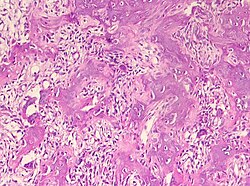Osteogenic tumors
Benign osteogenic tumors include: osteoma, osteoid osteoma, osteoblastoma.
Osteoma[edit | edit source]
Osteoma is a benign mesenchymal tumour belonging to the primary bone tumours. They are relatively rare, affecting mostly young individuals (under 20 years of age).
Osteoma is composed of more or less mature bone tissue (compacts - osteoma durum seu compactum, or spongioses - osteoma spongiosum). Macroscopically, it takes the form of a slowly growing bump. However, most of such processes are not true tumours, but various reactionary and post-traumatic processes. They are localized on the bones of the skull, especially the splanchnocranium and in the paranasal sinuses. Frequent complications (and in some cases the first manifestations of the tumour) are pathological fractures.
- The multiple occurrence of osteomas with familial colonic polyposis and benign soft tissue tumours is referred to as Gardner's syndrome.
Osteoid osteoma[edit | edit source]
Osteoid osteoma is a painful tumour up to 2 cm in diameter that occurs in people under 20 years of age in the cortical (superficial compaction) of long bones, especially the femur or tibia. It is usually located eccentrically in the diaphysis or metaphysis. Osteoid osteoma at the lesser trochanter: X-ray and MRI with clear sclerosis around the nidus. ! CAVE ! Osteoblastoma is mainly located in the pineal gland and does not sclerotize as much.
Osteoid osteoma of the distal radius on magnetic resonance imaging: significant surrounding edema in the fat-saturated sequence.
It consists of both an outer sclerotic rim (hyperostosis zone) and an inner so-called nidus (a tangle of fine osteoid lamellae, sometimes calcified, with osteoblasts perched on the surface of the lamellae, sometimes with osteoclasts present, the spaces between the lamellae are filled with a considerable cellular and vascular stroma). It may malignify into osteosarcoma.
Histology
Histological findings are similar to osteoblastoma.
Clinical picture
Manifested by nocturnal pain that subsides after antiplatelet agents (acylpyrine).
Diagnosis
X-ray examination shows a sclerotized bone deposit with spherical central lucency.
Therapy
It is treated by surgical removal of the nidus or radiofrequency ablation.
Osteoblastoma[edit | edit source]
Osteoblastoma (formerly giant osteoid osteoma) is a benign tumor, but with local aggressiveness. It occurs in younger people in the long bones (as well as osteoid osteoma), in the spine, jaws and elsewhere. Unlike osteoid osteoma, which can be considered a more differentiated variant of the same process, it is found in the spongiosa. It is larger than 2 cm (about 4-5 cm), is not bordered by a sclerotic rim, is highly vascularized, and may contain a large number of giant multinucleated cells.




